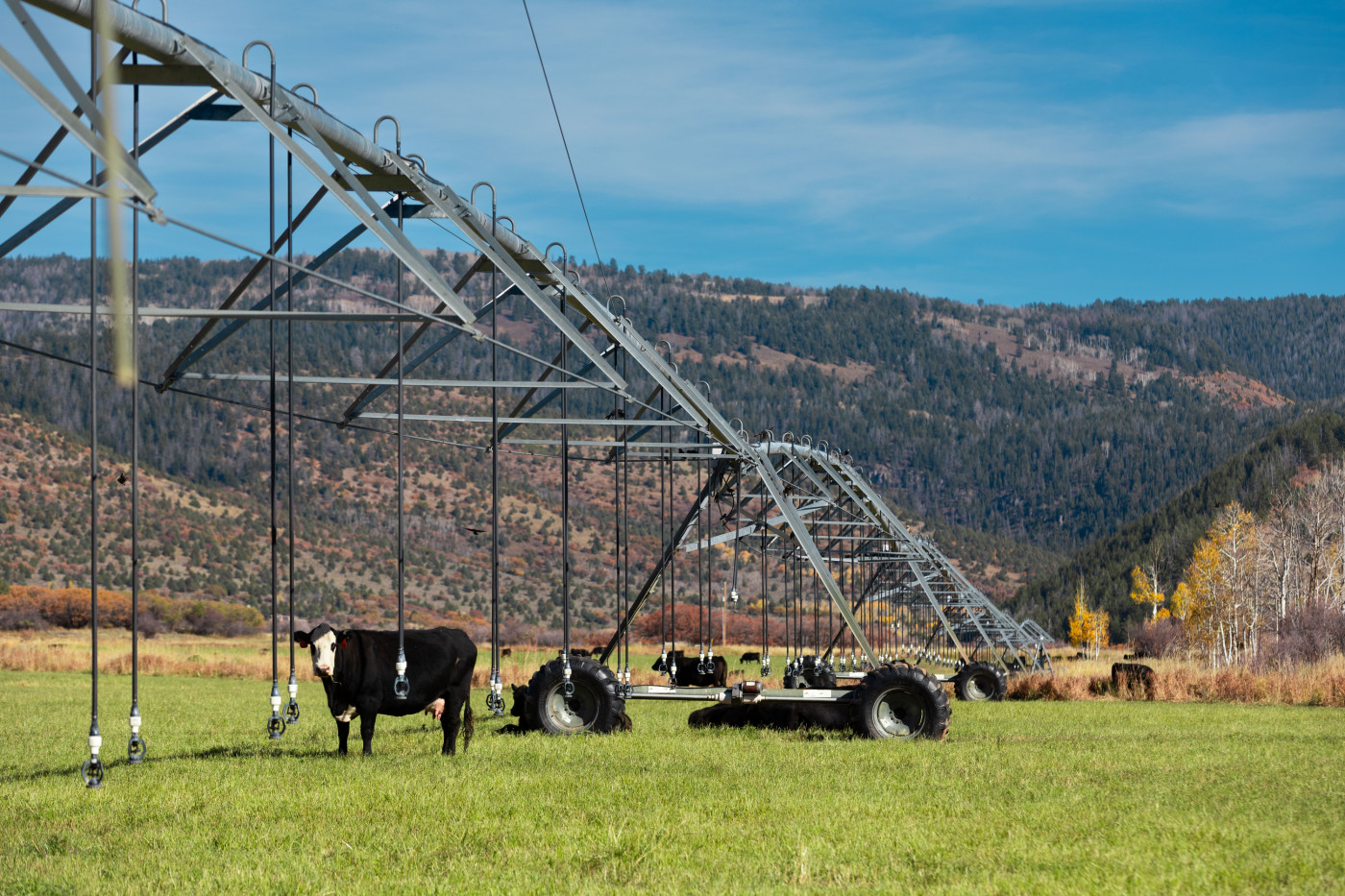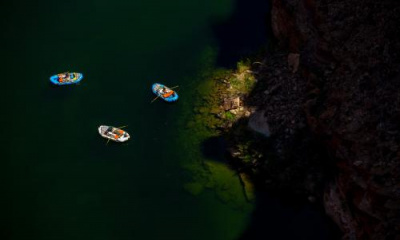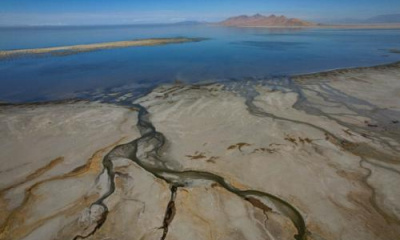Surprise: Agriculture and the lake need each other to survive
Editor’s note: This story is part of a series of stories by the Great Salt Lake Collaborative that asks the question: Why save the Great Salt Lake? It explores what opportunities open up in agriculture, daily life, industry and recreation by restoring the lake — or are ultimately lost without it.
For the 100-acre Johnson Family Farms in Cache County, things are generally looking up. Kelby Johnson, who runs the farm with his brother Braydon Johnson, recently left his side-job to run the farm full time and spend more time with his three sons, who Kelby hopes will one day become the fifth generation of Johnson family farmers.
But first he has to ensure the land remains a farm while pressure builds to sell to real estate developers, cut costs and save water for the Great Salt Lake.
The Johnsons have worked this particular farm in Cache County for the past 150 years. While the business has shifted from producing dairy, to raising hay, to today farming crops like onions, potatoes, peppers, tomatoes and squash, one thing is constant.
“You have to have an awfully big dose of entrepreneurship to be a farmer,” Kelby says. But for him, he says, “there isn’t any other job that works hand in hand with God to quite the extent that a farmer does. Because you can’t control the weather, you can’t control the markets, you can’t control the bugs and the pests and the weeds and all the other things that are out there.”
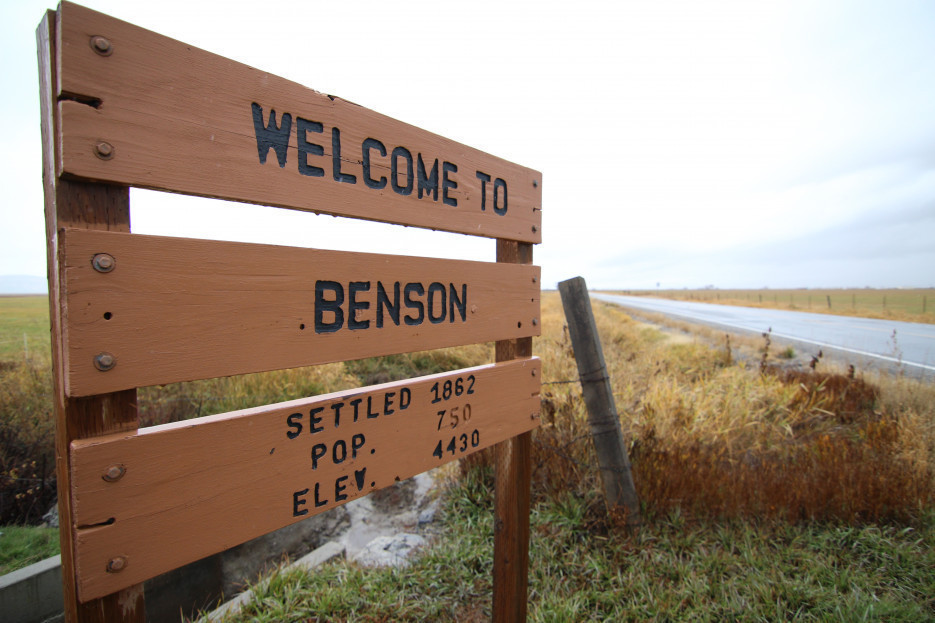
Kelby Johnson runs a 100-acre farm in Benson, Utah, with his brother Braydon. The Johnson family has worked the farm for the past 150 years and Kelby Johnson hopes his children will become fifth-generation farmers. But the Johnsons must withstand pressure to sell to developers and cut costs and water for the Great Salt Lake. (Jeffrey Dahdah, KSL-TV).
Kelby and his brother are well aware of the sorts of things out there on the horizon. They’ve both worked as agronomists, helping other farmers decide what kind of equipment to buy and how to manage their farms to make them more successful. They know of a handful of dairies in Cache County that have sold all their animals this year to pay off loans and try to remain financially solvent. Nearly all the costs of running a farm — labor, equipment, fuel and even water — have exploded in recent years, even as the price local grocery stores are willing to pay for their crops has decreased.
But when it comes to pressure to save the Great Salt Lake, saving water could help save the family farm.
Though often seen as being at odds with one another, Utah’s farms and the Great Salt Lake have a lot in common. Both have suffered as a result of the water crises of recent years, and neither is exempt from the tension building with the state’s ongoing development and growth. Stark economic conditions for local farmers and for the lake have led some to suggest it’s time for Utah to give up the pursuit of agriculture entirely and leave all that water for the lake.
But local food and agriculture play a deep role in Utah’s sense of place and purpose. In a series of 2015 surveys, the nonprofit Envision Utah determined that 97% of the state’s residents believe we should grow more food locally.
There are, experts say, alternative solutions that would allow Utah farms and the Great Salt Lake to not only coexist, but thrive side by side. For local farms to achieve financial sustainability, the cost of producing food locally must decrease dramatically. And many strategies for getting more water to the Great Salt Lake could also improve the financial outlook for local farms.
“If we could all work together for things that make sense for everyone, if we could put the differences aside and be honest and upfront, we could fix this in probably not very much time,” Kelby Johnson says. “If we could get to that point, I think most everyone in ag would love that. Because nobody is interested in a Great Giant Salt Dust Mess. Nobody is interested in the environment getting wrecked.”

Kelby Johnson with his sons Luke (in his arms) and Wyatt. Johnson runs a 100-acre farm in Benson, Utah, and hopes his children will become fifth-generation family farmers. But the Johnsons must withstand pressure to sell to developers and cut costs and water for the Great Salt Lake. (Jeffrey Dahdah, KSL-TV).
Stabilizing the Great Salt Lake
Any discussion of restoring the Great Salt Lake inevitably brings farms into the mix. After all, agriculture as a sector uses more water than all the cities and towns in Utah combined. Growing alfalfa, mostly to feed cows and other animals, is the single largest use of water that would otherwise feed the lake.
While all this is true, some common beliefs about the relationship between the Great Salt Lake and Utah agriculture require some correction, according to Utah State University agroclimate extension specialist Matt Yost.
Agricultural water use has not increased in recent years, Yost says. The amount of water used by farmers on the Wasatch Front has remained stable for the last several decades — and more recently may be decreasing. So agriculture is not to blame for the lake’s rapid decline in recent years.
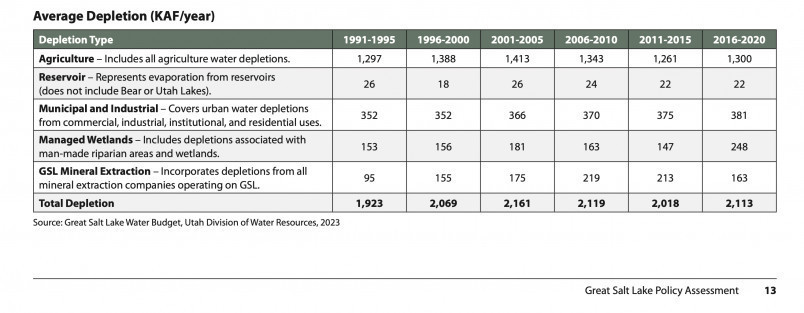
This table from the Great Salt Lake Strike Team report released Feb. 8, 2023 shows human water depletion by type of use.
That said, it won’t be possible to save the lake without the cooperation of Utah’s farmers.
“We’re finding that we can reduce consumption of water by probably 10-15% without affecting crop production. And most of that comes from reducing evaporation — that’s the major way we lose water that we can’t get back,” Yost says. “And if we do that across the board, we estimate we could send nearly 180,000-acre feet of water [a year] to the lake without affecting crop production.”
That’s about the minimum needed under conservative scenarios to raise the lake to 4,195 feet over 20 years.
Emerging technologies could potentially reduce water use from farms even further, and in many cases they could prove a boon to the farmers as well as the environment.
Harsh Economic Realities
Farming in Utah is naturally difficult. The high elevation, short growing season and yes, the lack of water, limit the number of viable crops farmers can choose from. Meanwhile, low-cost goods from national and international competitors with more favorable climates have cut profit margins razor-thin.
Faced with these economics, Utah farmers have engaged in a variety of solutions. Some have decided to exit farming entirely: the value of the land and water they own often exceeds the value of the crops they can produce, so they sell their property to developers. Between 2017-2022, Utah saw more than 500 farms go out of business, according to the USDA’s National Agricultural Statistics Service.
Other farmers like the Johnsons who want to see their farms stay in the family have opted to take second jobs to supplement their income and keep the farm afloat.
“It’s just a slow downward spiral for most farms,” Kelby Johnson says. “There’s not a lot of money in growing hay, so the kids say ‘OK, I guess I’ll get a real job,’ and eventually there’s no one left to take over and they’re left with the only option — selling out.”
Breaking the cycle, Kelby says, is a real challenge for farmers already dealing with slim margins. The Johnsons had hoped to shore up their own economic future by expanding their farm, but recently watched a plot of land they’d hoped to buy, sell to real estate developers at prices the Johnsons could never hope to pay.
“To see that go away because they can make a heck of a lot more money — you can’t blame them for that, everyone has to watch out for their own,” Kelby says, “but it’s sure hard when you work hard for something like that for a long time to watch it leave for a lot higher dollar.”
Silver Buckshot
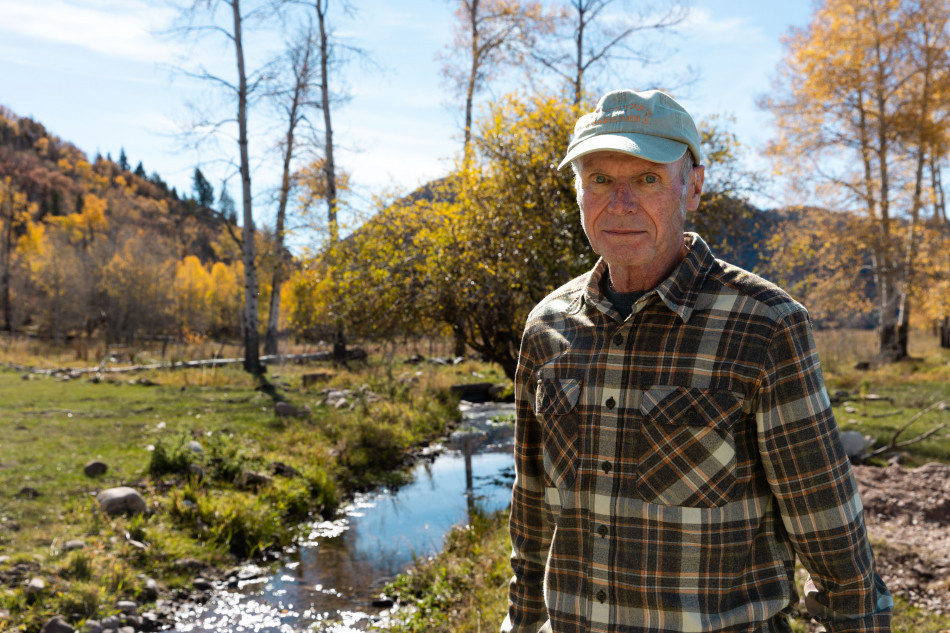
Steve Clyde stands by a flume, a humanmade channel for water, at his ranch in Kamas on Sunday, Oct. 15, 2023. Megan Nielsen, Deseret News.
The complexity of the challenges facing both the Great Salt Lake and local agriculture mean no one approach is likely to resolve either situation, says Emily Lewis, a partner at Clyde Snow Attorneys at Law who acts as project manager for the Utah Statewide Water Marketing Project, a water banking initiative that pays the owners of water rights to allow their water to flow to the lake. She prefers what she calls a “silver buckshot” approach — that is, the application of several smaller, but still effective, strategies all at once.
Yost points to vertical farming as one possible solution. Crops are grown in vertically stacked layers in a controlled environment that eliminates evaporation and recycles water. Using vertical farms to produce feed for animals — think hay and alfalfa — can produce more feed on less land, while also reducing water use by 90%.
Agrivoltaics — the practice of installing solar panels on farmland and growing crops in between — could also prove effective, Yost says. While there is some loss of crop productivity, the panels help reduce water loss by shading plants from intense sunlight, and the income from the solar panels helps boost farm profit margins.
And still other, if perhaps less futuristic, solutions might work. There are conventional solutions such as hoop houses and greenhouses that allow crops to be grown in enclosed or indoor spaces, which reduces water loss and expands the growing season. Newer irrigation equipment including smart-phone connected pivot sprinklers that rotate from a center point could go a long way. These reduce farm labor costs by enabling sprinklers to be operated by computer software that estimates crop water needs, and they can reduce water use 20% to 40% for the majority of existing farms, according to Jim Bowcutt, director of the Utah Department of Agriculture and Food’s conservation division.
Even changing from the practice of flood irrigation to a similar but newer surge irrigation concept could prove effective, Bowcutt says. Flood irrigation does have some benefits for the Great Salt Lake and the environment — routinely dousing fields to water crops helps recharge soils and the aquifers beneath them, and the unused water eventually finds its way to the lake. But exposing all that water to the open air for extended periods of time comes with high evaporation losses, and it can result in uneven watering that reduces crop productivity.
Surge irrigation follows a similar idea, but with new technology. The field is laser-leveled to ensure water can spread evenly across the surface, and then sprinklers placed strategically throughout the field open up and push a pulse of water across the field — just enough to dampen the soil around sensors placed beneath the field. It’s a new concept, but based on two farms where it has been installed in Box Elder County, it could prove as or even more water efficient than pivot-based sprinkler systems, Bowcutt says.
All of these strategies have the potential to increase farm profits either by reducing costs, or raising farm revenue. And the water savings could also benefit the farms’ bottom line: farmers can lease the water they own but don’t use to other parties — including, potentially, water banks dedicated to the Great Salt Lake. As with other solutions, the revenue from these leases could help decrease the cost of growing food in Utah and make local farming more financially viable.
“Putting in these systems increases yields and decreases manpower,” Bowcutt says. “Honestly the way it is right now with farms … it comes down to it’s hard to compete with development and the amount of money they can sell their crops for. So anything we can do to help producers get in the black a little more than the red helps.”
There’s still some legal work to be done here to ensure water freed up by water conservation at farms and other sources isn’t simply reabsorbed by additional urban growth, says rancher Steven Clyde, who moonlights as one of Utah’s most prominent water attorneys. The groundwork for the concept has been laid with legislative changes that have been made to facilitate shepherding water to the lake, but it will take time to implement, he says.
“Fallowing could be a component of this. Crop switching is a component of this, but a large part is just modernizing [farm] systems to use water more efficiently,” Lewis says. “But farmers can’t afford it. That’s why they haven’t done it yet.”
Paying the Bill
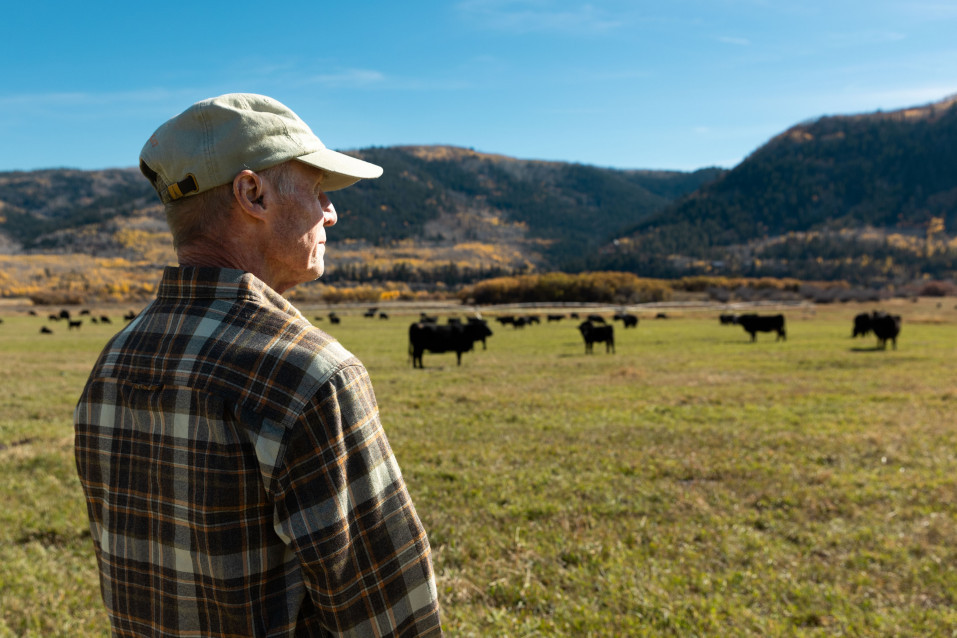
Steve Clyde looks out at the view of his ranch in Kamas on Sunday, Oct. 15, 2023. Megan Nielsen, Deseret News
Clyde himself has struggled to scrape together enough savings to upgrade his irrigation systems. He spent 20 years paying off two irrigation pivots even with the aid of a low-interest loan through the Natural Resources Conservation Service.
“We’re a fairly large operation,” Clyde says, “but if you have a [small] 10-acre farm, realistically you’re not going to get there.” Selling your water and your land to the highest bidding real estate developer is, in a growing number of cases, the only financially feasible option.
This is where programs such as the Utah Department of Agriculture’s water optimization fund, which received $200 million from the state Legislature this year, comes into play. This program provides farmers with grants of up to $500,000 to install water-saving technologies on their farm — with the caveat that the water savings cannot be used to increase the farm’s irrigated crop land. That is, the savings must permanently reduce the farm’s water use.
Although the program started with a single, relatively small appropriation of funds, Bowcutt says the department sees interest in the program grow every time they open a new round of water project applications. In 2022, the program paid for upgrades at 163 farms, saving over 80,000 acre feet of water or enough to raise the Great Salt Lake by more than an inch.
A Blue New Deal for Utah Farms
The Johnson Family Farm is already pretty water-wise, having replaced most of their older irrigation systems with pivot or drip-based water systems, Kelby Johnson says. But he sees ample potential for implementing water conservation at other farms — and they themselves have a few remaining fields that could stand to be upgraded.
But while conservation is generally good for a farm’s bottom line, Kelby says it isn’t just the upfront cost that has prevented him and other farmers from making upgrades to their irrigation systems. The frank reality, he says, is that he and other farmers do not trust state officials, and they remain leery of taking state money that they fear could have hidden strings attached.
For the last several decades, Kelby says, the state’s attitude toward farmers has been that they must use their water, or else surrender it to other uses around the state. If they don’t put the water they have on their fields, he fears the state will seize their water rights without compensation. Although a law passed in 2022 changes this, Kelby feels it hasn't been on the books long enough for the state to prove it's committed to this new approach.
“None of us are interested in losing one of the most important parts of our operation, especially after everything we have done to make it what it is,” Kelby says. “Do we want the Great Salt Lake to go dry? No. I don’t think anybody does. But how do we solve that problem? It’s going to have to come from people being personally motivated to make changes, and you personally motivate people by putting it in their best interest.”
There is, in Kelby’s estimation, a potential solution. If conditions on the lake improve, then revenues from other industries that rely on the lake — mineral extraction, brine shrimp, recreation, even real estate — will increase. Royalties and taxes will increase as a result of growing prosperity in those industries, putting more money in the state budget. Given that agriculture is the largest collective user of water, and given the outsized sacrifice farmers will have to make to realize this future for the benefit of all, Kelby argues that it would be reasonable for the state to kick some of the financial benefits back to the farmers themselves in the form of greater ag-oriented economic development.
This isn’t to say that the state doesn’t have dedicated programs for agricultural economic development, Kelby says — they do. But he recently watched a grant he applied for go to local food trucks instead of local farmers, suggesting to him that saving agriculture is not something the state takes very seriously.
Meanwhile, Utah farmers have struggled to find local outlets for their goods and wares. Since his local grain elevator went out of business, Kelby says he must drive to Idaho to sell grain — travel costs that further erode his ability to stay afloat.
“I wish as a state we had a little more vision and foresight to create better markets for agriculture, because right now we are losing a lot of our options,” Kelby says.
Thinking outside the box may be exactly what the state needs if it wants to both save the Great Salt Lake, and preserve local agriculture, says Lewis, the water banking project manager. The state has made significant strides toward protecting the lake in recent years, she says, and in the process they have realized the importance of listening to the state’s agricultural producers in order to fine-tune conservation programs in ways that benefit both the lake, and remain responsive to the needs of local farmers — whether those needs involve changes to state tax policies, or support for agricultural supply chains.
“It’s more than just asking the producers to do something different,” she says. “I want to take the state of Utah, pick it up, dip it in blue, and then pick it back up. To make real change, every aspect of the state needs to have a water bend to it.”

